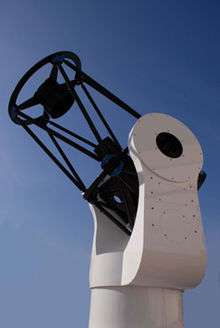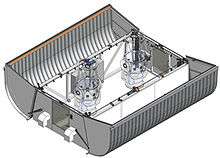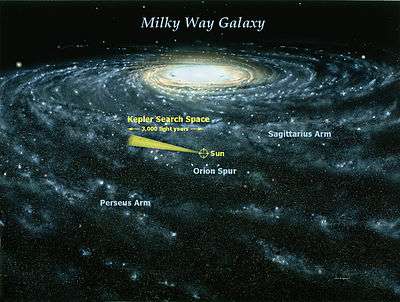Miniature Exoplanet Radial Velocity Array
The MINiature Exoplanet Radial Velocity Array (MINERVA) is a ground-based robotic dedicated exoplanet observatory. The facility is an array of small-aperture robotic telescopes outfitted for both photometry and high-resolution Doppler spectroscopy located at the U.S. Fred Lawrence Whipple Observatory at Mt. Hopkins, Arizona.[1][2][3][4] The project's principal investigator is the American astronomer Jason Eastman.[1] The telescopes were manufactured by PlaneWave Instruments.
 One of the individual telescopes of the Minerva project | |
| Part of | Fred Lawrence Whipple Observatory |
|---|---|
| Location(s) | Mount Hopkins, Arizona |
| Coordinates | 31°41′18″N 110°53′07″W |
| Telescope style | astronomical survey optical telescope |
| Website | www |
 Location of Miniature Exoplanet Radial Velocity Array | |

Science objectives
The primary science goal of MINERVA is to discover Earth-like planets in close-in (less than 50-day) orbits around nearby stars, and super-Earths (3-15 times the mass of Earth) in the habitable zones of the closest Sun-like stars. The secondary goal is to look for transits (eclipses) of known and newly discovered extrasolar planets. The unique design of the MINERVA observatory allows the pursuit of both goals simultaneously.
Specifications and status
- Telescopes: Four PlaneWave CDK700, 0.7m telescopes within 2 custom telescope enclosures designed by LCOGT engineers. One MINERVA-Red telescope
- Cameras: 2k × 2k back illuminated CCD with 15 µm pixels offering > 20’ f.o.v.
- Spectrograph: Stabilized, R = 75,000 echelle spectrograph with iodine cell for precise radial velocimetry designed by KiwiStar Optics (a business unit of Callaghan Innovation; a New Zealand government-owned Crown entity).
- Status: Full photometric science operations began in May 2015 at FLWO. The spectrograph was installed Dec 2015.
MINERVA-Red
MINERVA-Red is an echelle spectrograph optimized for the 'deep red', between 800 nm and 900 nm (where M-dwarfs are brightest) with a robotic 0.7 meter telescope. It uses a Fabry-Perot etalon and U/Ne lamp for wavelength calibration.[5][6]
See also
- List of extrasolar planets
Other exoplanet search projects
- HATNet Project (HAT)
- Kilodegree Extremely Little Telescope (KELT)
- Next-Generation Transit Survey (NGTS)
- Trans-Atlantic Exoplanet Survey (TrES)
- XO Telescope
References
- "A dedicated Exoplanet Oservatory". Harvard. 3 February 2016. Retrieved 3 February 2016.
- Gudmundur Stefansson (26 December 2014). "MINERVA: MINiature Exoplanet Radial Velocity Array". astrobites. Retrieved April 2016. Check date values in:
|access-date=(help) - Kristina Hogstrom. "MINERVA: Using Small, Fully Robotic Telescopes to Search for Habitable-Zone Exoplanets". NASA. Retrieved April 2016. Check date values in:
|access-date=(help) - "Earth-hunting, guerilla style". Planetquest JPL/NASA. 6 September 2012. Retrieved April 2016. Check date values in:
|access-date=(help) - Sliski, David; Blake, Cullen; Johnson, John A.; Plavchan, Peter; Wittenmyer, Robert A.; Eastman, Jason D.; Barnes, Stuart; Baker, Ashley (2017). "MINERVA-Red: A telescope dedicated to the discovery of planets orbiting the nearest low-mass stars". American Astronomical Society Meeting Abstracts #229. 229: 146.09. Bibcode:2017AAS...22914609S.CS1 maint: uses authors parameter (link) MINERVA-Red: A telescope dedicated to the discovery of planets orbiting the nearest low-mass stars
- https://video.ias.edu/jointastro/2015/1006-CullenBlake
External links
- Miniature Exoplanet Radial Velocity Array (MINERVA) I. Design, Commissioning, and First Science Results
- Dr. John Johnson – Lecture: Exoplanetary science and Kepler mission update on YouTube (time 25:01 min.)
- Minerva-Red

